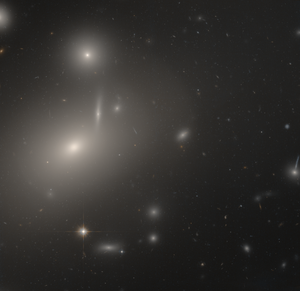NGC 4882
| Galaxie NGC 4882/NGC 4886 | |
|---|---|
 | |
| Hochaufgelöste Aufnahme der elliptischen Galaxien NGC 4882 und NGC 4889, erstellt mithilfe des Hubble-Weltraumteleskops | |
| AladinLite | |
| Sternbild | Haar der Berenike |
| Position Äquinoktium: J2000.0, Epoche: J2000.0 | |
| Rektaszension | 13h 00m 04,4s[1] |
| Deklination | +27° 59′ 15″[1] |
| Erscheinungsbild | |
| Morphologischer Typ | E0[1] |
| Helligkeit (visuell) | 13,9 mag[2] |
| Helligkeit (B-Band) | 14,9 mag[2] |
| Winkelausdehnung | 0,6′ × 0,6′[2] |
| Flächenhelligkeit | 12,9 mag/arcmin²[2] |
| Physikalische Daten | |
| Zugehörigkeit | Coma-Galaxienhaufen Abell 1656[1] |
| Rotverschiebung | 0.021321 ±0.000014[1] |
| Radialgeschwindigkeit | 6392 ±4 km/s[1] |
| Hubbledistanz H0 = 73 km/(s • Mpc) | (286 ± 26) · 106 Lj (87,8 ± 8,1) Mpc [1] |
| Geschichte | |
| Entdeckung | Heinrich d’Arrest |
| Entdeckungsdatum | 6. April 1864 |
| Katalogbezeichnungen | |
| NGC 4882, 4886 • PGC 44698 • MCG +05-31-076 • GC 5697, 5699 • | |
NGC 4882 = NGC 4886 ist eine 13,9 mag helle Elliptische Galaxie vom Hubble-Typ E0 im Sternbild Haar der Berenike, die etwa 286 Millionen Lichtjahre von der Milchstraße entfernt ist.
Sie gehört zum Coma-Galaxienhaufen und wurde vom deutsch-dänischen Astronomen Heinrich Louis d’Arrest gleich zweimal entdeckt; zuerst am 6. April 1864 (geführt als NGC 4886),[3] danach erneut am 22. April 1865 (geführt als NGC 4882).
Weblinks
- NGC 4882. SIMBAD, abgerufen am 20. Februar 2015 (englisch).
- NGC 4882. DSO Browser, abgerufen am 20. Februar 2015 (englisch).
- Auke Slotegraaf: NGC 4882. Deep Sky Observer's Companion, abgerufen am 20. Februar 2015 (englisch).
Einzelnachweise
Auf dieser Seite verwendete Medien
Autor/Urheber: Judy Schmidt from Fresh Meadows, NY, USA, Lizenz: CC BY 2.0
A dominant member of the Coma Cluster, remarkable elliptical shell galaxy NGC 4889 looms large over its domain. Within the cluster, only NGC 4874 (not shown) is brighter, and only just barely.
The faintly visible shells of the galaxy are evidence that the monstrous galaxy recently merged with a smaller galaxy.
Other details to notice include smaller and/or more distant elliptical galaxies, some of which are ghostly and faint. I have seen them called them fluffy galaxies in this recent press release. The nature of these ultra-diffuse galaxies and specifically how they manage to form as they do is still a matter of speculation.
Very few Milky Way stars are visible within the field. As usual, the ones with four spikes are most likely foreground stars. The hundreds of tiny, fainter point-like objects are globular clusters, many of which are likely orbiting NGC 4889.
Do you think that maybe some background galaxies show a curious alignment? You might not be imagining it. It's possible that some weak gravitational lensing is going on. Weak gravitational lensing is detectable by taking measurements of all the background galaxies and seeing if they all seem a bit squished in a certain direction.
One final curiosity that I would like to note about NGC 4889: If you measure the brightness of the center of its nucleus, it is actually not as bright as NGC 4886, which is the smaller elliptical galaxy just above it in this image (that one skinny galaxy is kind of pointing toward it). The way some elliptical galaxies have diffuse cores while others have very sharp ones is something that perplexes me. It seems that even though NGC 4889 is much larger than NGC 4886, its nucleus is notably less dense than NGC 4886's.
Red: ACS / WFC F814W (jb2i02020_drc) Green: Pseudo Blue: ACS / WFC F475W (jb2i02010_drc & jb2i03010_drc)
North is NOT up. It is 43.6° counter-clockwise from up.